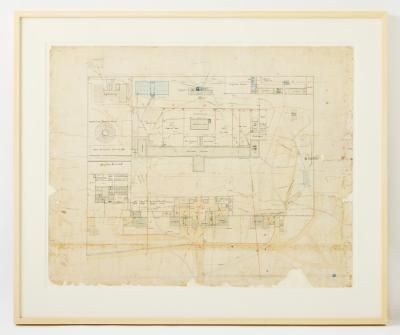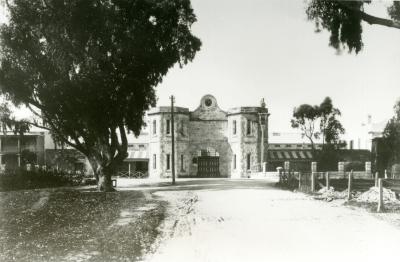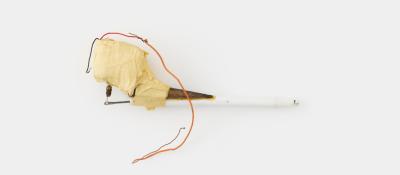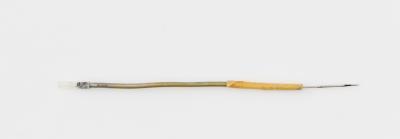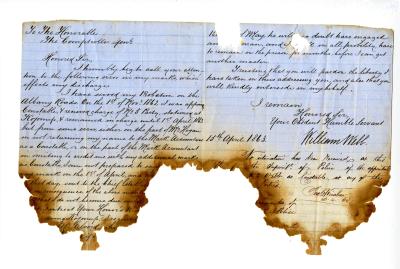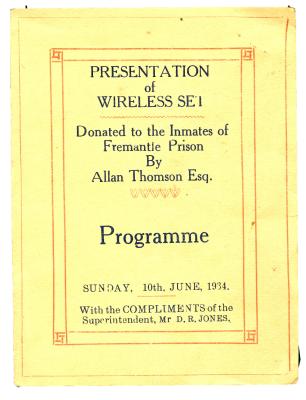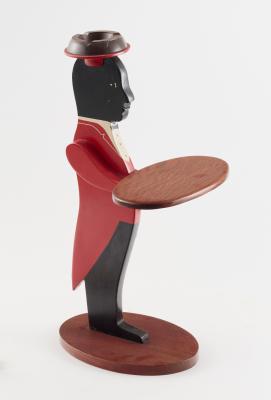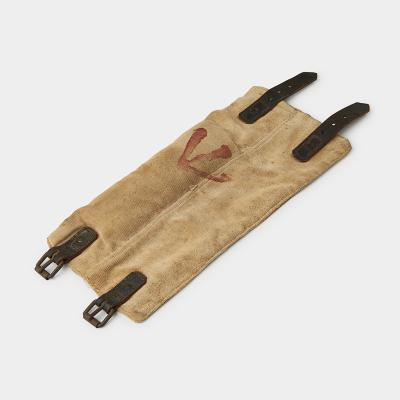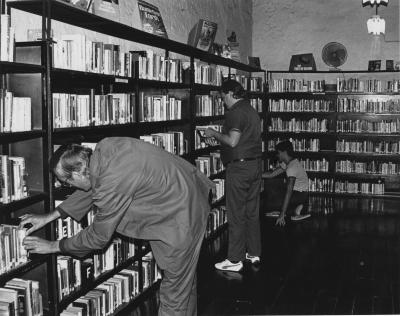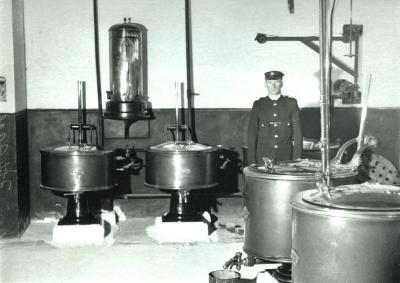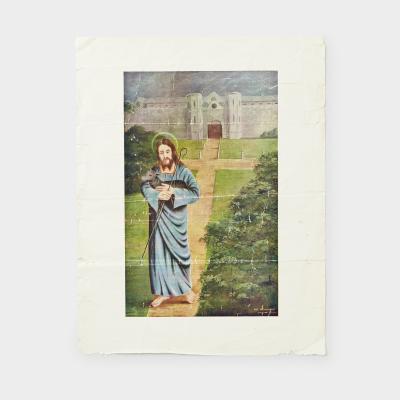12 GAUGE GREENER SHOTGUN
Long, thin, metal and wood Greener shot gun. A Greener brand 12 gauge single shot shotgun, serial No. 33320. Large, rectangular, wooden stock with metal loading/firing mechanism and barrel. Maker's marks engraved on one side of metal loading/firing mechanism reads, 'GREENER'S/ GP/ GUN'. On the opposite is engraved, 'W.W. GREENER MAKER/ BIRMINGHAM ENGLAND'. Stamped into the metal of firing mechanism is '33320'. Engraved into the wood is '33320' again. Engraved on the top of the barrel near the firing mechanism is '729/ crown BNP/ 12 [in a diamond] 2 3/ 4''/ 3/ 4 TONS PER [figure of square and inch mark]/ H/ [two swords crossed over]/ B'. Engraved on the top of the barrel is, 'MADE/ IN/ ENGLAND'. Engraved on the butt is the Greener logo with an elephant and 'TRADE/ MARK'.
Donated to the Fremantle Prison Collection by Officer D. Harris of Canning Vale Prison Armoury (under Ministry's Curio Licence) in October 1991. Transferred back to Officer Bob Nicholson, Canning Vale Prison Armoury in October 2000 before being transferred permanently to Fremantle Prison.
Details
Details
'GREENER'S/ GP/ GUN', 'W.W. GREENER MAKER/ BIRMINGHAM ENGLAND', '33320', '33320', '729/ crown BNP/ 12 [in a diamond] 2 3/ 4''/ 3/ 4 TONS PER [figure of square and inch mark]/ H/ [two swords crossed over]/ B', 'MADE/ IN/ ENGLAND', 'TRADE/ MARK'.
In 1829 W.W. Greener founded the W. Greener company in Newcastle. The company moved to Birmingham in 1844 where most of the materials used to fabricate the guns originated from. His son, William Wellington Greener created a company of his own, W. W. Greener which started producing the first breech-loader in 1864. At the death of William Greener both companies were amalgamated together under the name W.W. Greener Company. Several innovations made the company famous and prosperous. In the early 1900s the British Government commissioned a special shot gun from Greener to arm its colonial police forces. The design of the shotgun was based on the Martini-Henry rifles and was designed for 14 or 13 gauges. Some were made for 'regular' chamberings, like the 12 gauge with 2 3/4'' shells sold in the States during the 1930s. This shotgun fits this description (see http://www.guns.com/2013/03/11/the-greener-police-shotgun-engineered-gun-control/). The W.W. Greener Company is still active today.
During the twentieth century Fremantle Prison had an armoury, with a dedicated armourer who was responsible for all firearms. The armourer trained Prison Warders in the correct and safe use of firearms, and supervised their practice sessions. Such instruction was carried out in an area known as the Rifle Range, located at the rear of the West Workshops.
In the relatively open precinct of the original Convict Establishment, Comptroller-General Henderson placed gun towers on the highest points of the perimeter walls, including Church Hill on the south knoll, and adjacent to the present day reservoir to the east of the site. These towers have since disappeared, but exactly when or why this happened is not known. It appears that during this period, apart from these two early watch towers, most of the guarding was done at ground level, with sentries posted at various locations within the Establishment near the perimeter walls.
By 1926 reports show that there were now four gun towers on the site; one on the northern wall of the Women’s Prison near the northern end of the West Workshops, a second in the north-east corner of the site near the Prison Hospital, a third on the south wall in the south-east corner, and a fourth was completed in 1926 with a sentry walk on the walls over the prisoner reception rooms. In the 1950s patrols were conducted at ground level, and the gun towers were not manned at night. However, by the 1960s the gun towers were manned both day and night, with only the east bank and Prison Hospital area patrolled at ground level. At this stage, although the gun towers were manned at night, they were not lit. This was to prevent the prisoners seeing the officers inside and also to stop the interior being reflected back in the glass and obscuring the officers’ view. By the 1970s a fifth gun tower was installed on the north wall in the north-west corner. After the Fremantle Prison riot in 1988, a sixth gun tower was also added on the north wall of the East Workshops.
The Officer who patrolled the east bank overlooking the exercise yards was issued with a revolver plus 12 rounds of ammunition after lockup every afternoon. The gun and ammunition where then returned to the armoury in the morning before the cells were unlocked. Apart from the guards in the gun towers, this was the only officer on site issued with a firearm. During his patrol he checked security at places such as the Prison Hospital and kept an eye on the rear of the Main Cell Block.
Prison issued rifles had a magazine of five bullets, with a spare magazine also issued to carrying officers. Gun posts also contained a box with a glass face, holding bullets for use in any emergency. The glass in the box could be broken in order to obtain the ammunition contained inside. Depending on the firearm, bullets could cost anywhere from 10 to 40 cents each. Officers were accountable for the bullets they were issued with, so they would be checked at the beginning and end of each shift. Fremantle Prison guards were only authorized to discharge their firearms in the event of an escape attempt. Guards could only fire on escapees after first blowing their whistle as a warning and once a prisoner was physically on top of the perimeter walls, even then the guard was only authorized to shoot to injure, not to kill. Whilst escape attempts from Fremantle Prison usually resulted in the escapees being recaptured fairly quickly, some instances did result in guards discharging their firearms, occasionally with tragic consequences.
In 1967 the number three gun post officer noticed a prisoner on the roof of the East Workshops. Following correct procedure, the officer first blew his whistle to alert the prisoner that he had been seen, and to communicate to other officers that an escape attempt was in progress. When the prisoner failed to respond appropriately the officer then proceeded to fire a warning shot in the prisoner’s direction. At this point the prisoner fell off the roof onto the ground where he remained still. When officers went to check on his condition, they found him unconscious and assumed he had experienced a heart attack from the shock of the incident. He was taken to the Prison’s Hospital where he later died. His body was then taken to the Fremantle Hospital where an autopsy discovered that he had been killed from a gunshot wound. It was then discovered that the warning shot fired by the officer had unintentionally ricocheted, hitting the prisoner and fatally wounding him. Although the officer who fired the warning shot was found to have followed the correct procedure at all times, the incident led to ill feelings between him and some of the inmates, who used the situation to taunt him. Eventually the Officer in question resigned from his position at the Prison.
